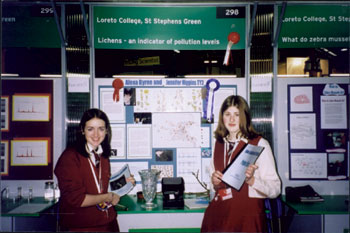| 2003 |

|
YEAR BOOK |
Loreto College, St Stephen's Green, Dublin
|
Lichens as pollution monitors
|

Lichens have no roots - therefore they rely on moisture from the air and the nutrients contained within it. They absorb this moisture directly and, as they have no filtering system, they must also absorb any pollutants contained in the water.
SO 2 is the main cause of lichen death. It is present in the atmosphere in industrial towns and cities. The SO 2 reacts with the water in the atmosphere to form a weak sulphuric acid. When the lichens absorb this moisture, it kills them.
In 1988, a survey was conducted by An Foras Forbartha and Dr �anna Ni Lamhna. The purpose of this survey was to study the lichen population of Dublin and compare the findings with SO 2 levels.
We read this survey and noted that lichens were more prevalent in areas with lower SO 2 levels. Taking into account the fact that the burning of smoky coal had been banned in 1990, which we thought must have affected lichen growth, we decided to update the survey on a smaller scale.
The original survey took a map of Dublin and divided it into over 300 squares to study. We chose 30 of those squares (approximately 10%) to revisit. We used the same methods employed in the Foras Forbartha report - we chose 10 random trees in each square and identified the lichens on the tree using a chart and a magnifying glass.
Our results were surprising. Considering the fact that SO 2 levels have fallen all over Dublin since 1990, lichen recovery would have been expected in all areas. However, they had only recovered in 17 of the 30 squares. In 9 squares they remained the same and 4 squares recorded a disimprovement.
Our theory is that lichens are affected by the massive increase in car use in the greater Dublin area over the past decade. The petrochemicals in car exhaust fumes (even unleaded) have an effect on lichens. Until we stop taking the car, our lichens cannot be restored.
Alexa Byrne & Jennifer Higgins won first prize in the Intermediate Group Section in the Biological & Ecological Sciences Category at the EsatBT Young Scientist & Technology Exhibition in January 2003. They also won a Special Award presented by the Environmental Protection Agency.
Their teacher was Ms Sheila Porter.
|
|